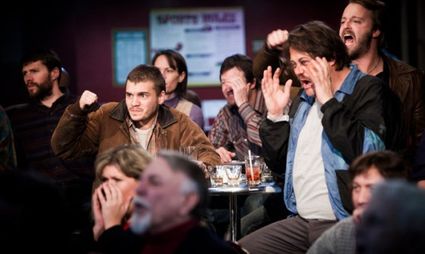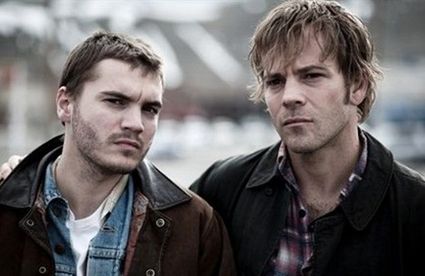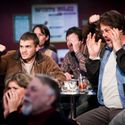The Motel Life
November 14, 2013
An exploration into sibling relationships set in a world of life on the wrong side of the tracks comes to us compliments of real-life brothers, Alan and Gabriel Polsky, who make their feature co-directorial debut with THE MOTEL LIFE. Although losing some depth and gravitas due to a scantily developed backstory, the emotional strength of the film is buoyed by a superlative performance by Emile Hirsch buttressed with perhaps the most potent work we've ever seen from Stephen Dorff.
Frank and his older brother Jerry Lee have been on their own for awhile. Losing their mother some years back, their inheritance consisted of $500.00, their father's gold Winchester rifle and a death-bed directive from their mother that they always stay together. Taking their mother's words to heart, the pair are virtually inseparable, no matter what the difficulties or what trouble befalls them; and no matter how many times Jerry Lee tries to venture forth alone because of some mess he has created that Frank needs to clean up. One of those "messes" involved an attempt at hopping a freight train; an event that cost Jerry Lee a leg. And now, Jerry Lee has created a new situation that must be handled.
Living a life on the rails and moving from one motel room to another, their escape from the harsh hand they have been dealt is stories. Frank has always been able to spin a mighty good yarn while Jerry Lee has immense artistic talent, adorning their motel room walls with his drawings that span their collective lifetime. But tall tales and pretty pictures may not get them through this latest trouble.
Drunk and driving in a late night snowstorm with zero visibility, Jerry Lee hits and kills a young boy on his bicycle. Fleeing the scene in typical Jerry Lee fashion, in a panic, Jerry Lee drives the car to a remote location, sets it on fire and then shoots himself in the leg. Always appearing a little bit slow on the mental uptake, Jerry Lee turns to Frank for help. Frank, unfortunately, has his own alcohol-fueled demons to deal with. As Jerry Lee lands in the hospital to recover from his self-inflicted gunshot wound, Frank is out hustling up some cash to make a hasty getaway and sidestep the law, who are actively searching for the hit and run driver and getting closer by the minute to discovering Jerry Lee as the culprit.
As the brothers come face-to-face with their own mortality, their relationship grows ever deeper, their individuals past mistakes and secrets hidden deep below the surface bubble forth and each tries one last time to become the kind of man - and brother - each dreamt of being.
With THE MOTEL LIFE, the shining star is two pronged; the first prong being Emile Hirsch. Packing an emotional punch, Hirsch delivers a thoughtful powerful performance that tacitly speaks volumes with elegant emotional nuance through observation. His character development is defining and distinctive, peppered with precious moments of joy where his eyes light up when Frank is telling his fabulous stories. It is impossible to take your eyes from the screen. Doesn't matter if we're seeing a close-up or a two-shot pairing Hirsch with Dorff or co-star Dakota Fanning, Hirsch is mesmerizing. He captivates with his silence and with the light, or sadness, in his eyes. His exchanges with Kris Kristofferson's Earl Hunley are priceless, filled with loving paternal notes.
And what about Stephen Dorff's turn as Jerry Lee? This is something we have never seen previously from Dorff. He really pushes the envelope to remove his usual hard, cocky edge and delivers a memorable performance as an emotionally stunted man brimming with childlike naivete. At first you think Jerry Lee is playing "dumb" to avoid dealing with life, but Dorff slowly draws you in and you realize this is how Jerry Lee deals with the world - he never learned how to be an adult. He is, in essence, trapped in the hopeful fantasy of childhood where you can be anything you want to be and the world can be whatever you want it to be. Great dichotomous character construct positing the physical and to a degree, mental, disability against the dreams of a child reflected in his drawings. Telling is Jerry Lee's insistence at buying magazines for the family of the boy he killed given that for the period during which this is set, and for a child of that generation, magazine sales were how you raised money for school, Boy Scouts, Girl Scouts. A loving touch in the storyline. And Dorff runs with it. We feel Jerry Lee's pain, but once we get into the third act, Dorff starts losing my empathy and understanding as the aura he's emitting as Jerry Lee becomes more "pathetic" and helpless. At no time did I ever see Jerry Lee as helpless up until that point when he pisses and moans that he can't even hop to the bathroom. And that's where Dorff loses footing (pun intended) in the performance.
Very poignant and beautiful performance by Kris Kristofferson as Frank's "mentor", used car dealer Earl. On the other hand, Dakota Fanning is somewhat wasted as Frank's past love, Annie James.
Written by Micah Fitzerman-Blue and Noah Harpster based on the novel by Willy Vlautin, THE MOTEL LIFE is all about "storytelling" - the second prong of the shining star - "storytelling" on multiple levels with fantasy and real life colliding sometimes in a moment of quicksilver and other times in sadness - but even that sadness leads to inspiration and hope. With a contained physical construct of life in a motel room, the novel and script tap into the only outlet for a motel lifer - one's imagination. And that's exactly what Frank and Jerry Lee do through Frank's stories and Jerry Lee's drawings. The Polskys excel with their direction at honing in on and capturing that element. Without the stories and drawings, the film would have fallen flat. That sense of imaginary exploration is what breathes life into THE MOTEL LIFE, imagination that is then fantastically rendered through animated vignettes scattered throughout the film as segue and scene changes. Adding a top note to the imaginary stories and drawings is that they do not mimic the lives of Frank and Jerry Lee, but expand them and go beyond, creating worlds and events the boys only dream of experiencing.
The animated sequences are stunning. Nothing fancy, but charcoal/pastel/grease pencil looks and a few pen & ink animations with the "Flannagan Brothers" as RAF pilots. The animation - even with the soft porn, naked breast drawings - is actually quite innocent reflecting the childish naivete of Jerry Lee.
Production design is beyond appropriate. We feel the claustrophobia of the motel rooms and the reality in which the boys live. Cinematographer Roman Vasyanov, of whom I am a huge admirer, excels with creating a visual tonal bandwidth that both mirrors the claustrophobia of the boys' world, while turning it on its ear with some expansive wide shots of the crystalline glistening white cleansing snow. (Love the whole snow metaphor going on anyway). Vasyanov did something similar with "The East" in its lighting and lensing to great effect and I see the same elements here - worlds colliding, hopes, dreams. Beautifully shot is a cabin scene with Dakota Fanning and Hirsch - purity of white snow outside, golden warm fire and glow inside; similarly, another motel room and the bakery where Fanning's character of Annie works - white, clean crisp, pure; like life reborn and the slate wiped clean. Almost celebratory is the shadowed imagery of the motel rooms contrasted with zooms into Jerry Lee's drawings taped on the walls. As the camera zooms in on select drawings, the walls of the room fall away, removing the claustrophobia and in most cases, serves as a segue into an animated sequence. The camera sweeps us out of the grit of the Flannagan boys' life and into the "what if" world. One thing I am surprised was not incorporated into the production design - a cowboys and Indians blanket or quilt from the boys youth. With the "old west" dreams and motifs of being "renegades", on the run, living hand to mouth, etc., I really expected to see them holding on to a blanket like that from their days as children.
There are a few continuity issues that serve as distractions starting with the disappearance of Jerry Lee's prosthetic leg. More disturbing, however, are scenes of Dorff as bedridden Jerry Lee post-surgery in a pristine hospital bed where the bottom of one foot is always on camera. It's black with dirt. Common sense tells us the foot would have been cleaned by the hospital when he was shot and brought in, and he wasn't hopping on the floor, so why are we seeing a filthy dirty foot sole?
Not to be missed is Mike Smith's animated desert lizard which is obviously inserted as an homage to Werner Herzog whose film "Bad Lieutenant" was produced by the Polskys and who, in return, is now championing the Polskys' work. As any Herzog fan knows, he is famous for sticking non-sequitur lizards, crocodiles, chickens, etc. in his films so this loving touch is a real gem to see.
Storytelling at its finest, THE MOTEL LIFE is a deep reflection on the human condition and brotherly love.
Directed by Alan Polsky and Gabriel Polsky
Written by Micah Fitzerman-Blue and Noah Harpster based on the novel by Willy Vlautin
Cast: Emile Hirsch, Stephen Dorff, Dakota Fanning, Kris Kristofferson



























Reader Comments(0)